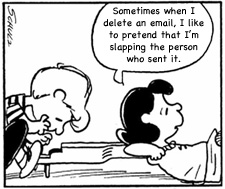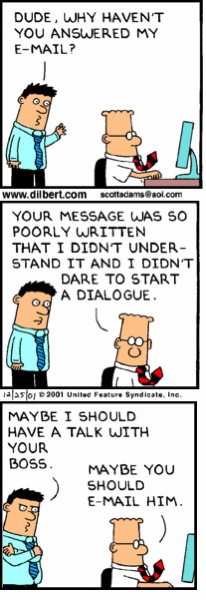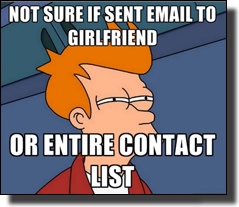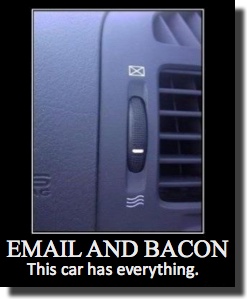 Every great movie has a memorable line that becomes fodder for the memeosphere. “If you build it, he will come” was the hot line from Field of Dreams, the 1989 classic. The line implied that by simply building a baseball field, something mysterious was going to happen.
Every great movie has a memorable line that becomes fodder for the memeosphere. “If you build it, he will come” was the hot line from Field of Dreams, the 1989 classic. The line implied that by simply building a baseball field, something mysterious was going to happen.
It seems we may have adopted this adage when it comes to email.“Send it and they will read” seems to be the battle cry of millions of corporate citizens. There is a failure to recognize that the burden of communicating falls on the sender, not the receiver. If your email is not read, it’s because you didn’t make it readable. Readable emails get read – it’s that simple.
I would venture that over half of the emails I open are not readable. Most of them are too verbose, lacks an obvious purpose, have the wrong people in the sender list, or are only sent to cover one’s posterior. If I could avoid reading those, I would. Unfortunately buried deep within the bowels of some email is an important nugget of information that I need. Since I can’t tell ahead of time which emails are of value, I am forced to read the rest in frustration.
The reason I know this is because I have been perpetrating these crimes of email waste myself for the better part of my career. I am willing to bet that you have too. Here are some rules that I try to follow.
1. Learn from journalists
People like to read email the same way they like to read the news. They want to be able to stop reading when they have all that they care to know.
- Write your emails as a journalist would. The first sentence or paragraph captures the general point that everyone will need to know and then proceed into finer detail as the message continues. This is especially true when your audience is diverse, each person requiring a different level of detail.
- Mind the “fold.” In newspaper parlance, the fold is that crease created halfway down, where the paper was folded to fit into the newsstand. Editors knew that nearly everyone that passed the newsstand would see the headlines above the fold and that articles below the fold were only available to those that purchased the paper. If you wanted them to buy your paper, you had to entice them with words above the fold.
In today’s world, the fold is what can be seen in one screen on a mobile device, typically about 50-80 words. When someone is reading their email on their phone, it is very likely they will only read what is above the fold unless they have a reason to read further. If you want them to read your email, entice them within in the first 50 words.
- If action is required by others, state that first, or at least indicate that they need to read further as action will be required. Include the deadline as well. Too many emails explain in great detail the situation and then say “I need you to…” Ugh.
2. Title Matters
- The title is the only thing guaranteed to show up in an inbox – make it a good one. Emails with vague titles get lost.
- If there is a call to action, consider including “Action Required.”
- Likewise, if there is a deadline, include it in the title
- Figure out the fewest number of words that can disambiguate your email from the countless others on the subject. Consider “Expense report for Donald’s toupee” over “Expense report.” You want the title to instantly reflect what the email was about, so that a person looking for it later could quickly find it without having to open up the email.
- Keep in mind that most inboxes will only see 5-8 words of the title before truncating them for space. If you need to put action required or a date in the title and it makes the title too long, consider moving them to the first line of the text.
3. Add value before forwarding
Don’t forward on a long stream of email interactions and only say, “FYI” in the body. This basically says your time is much more valuable than theirs. Add value to the interaction.

- Tell them why you wanted them to see this. You obviously thought it was important, so were you looking for action on their part? Did you want them to get involved? If you wanted them to come away with a position, tell them what that position should be. Add value, otherwise you are being lazy.
- If there is a long thread of conversations in the forwarded email, please don’t make them read it unless absolutely necessary. Reading a document from bottom up is a pain and often contains a lot of extraneous commentary. Summarize the conversation, and if they need details, they’ll read the rest, just like the newspaper article we discussed.
- If you can’t summarize it well, at least cut out all of the parts that don’t add to the conversation. Most people don’t care that Suzy thought that Rachel’s point was “well said.” Again, add value, otherwise you are being lazy.
4. Add value before linking
A lot of people like to share articles that they have read by including a link and saying, “I thought this might interest you.”
- If you are only going to include the link, give them a quick blurb about why you thought they should read the article. Otherwise they are likely to ignore it.
- Consider pasting the article’s text in with the link. This is helpful if the reader is using a remote device with a small screen. It removes all of the browser real estate, plus prevents them from having to go somewhere else to read. Be mindful of any copyright issues that may apply.
- If you are including an article in the email, highlight the key ideas. It lets the reader know why you thought this was important, possibly producing great fodder for a future discussion. It also allows them to skim the highlights to determine if the article is of interest to them.
- Better ye, consider copying the text you just highlighted and pasting it before the article – kind of like an executive summary. Your audience will greatly appreciate it.
5. Consider your recipients carefully
There could be a whole article on this topic alone. Let’s stay with a few of the basics.

- Always try to make a recipient list as small as possible. Ask “What are the fewest number of people I can include in this list and be equally effective?” Imagine that every person you added cost you a dollar – who would you include? Well, the fact is that the average cost to read a single email is around $2 per person. Got 50 people on that distribution? That’s $100.
- Once you have the list, follow the rule I outlined in Phoning It In – let people know why they were included on the recipient list. If you can’t answer this for everyone, they won’t know either and will likely consider the email a nuisance.
- Keep To: and CC: distinct and purposeful. Use the To list to include those that require action – either a response, an acknowledgement, or some other activity. CC: should be used for anyone else.
- With one exception, never use BCC. Never. It will only come back to haunt you – especially when the BCC’d person does a Reply All and everyone discovers you BCC’d them. The exception is if you BCC everyone as a technique to avoid getting replies sent to the whole group.
- If you expect action from a group of people, consider the countless studies on group behavior that sugget when one sees themselves as part of a group they are less likely to take action. It’s why it is common to hear about a crowd witnessing a crime and everyone thinks someone else has called the police. If a group is necessary, explicitly state that you need everyone on the To: list to respond, or call out each individual by name, indicating what type of response you need from them.
- Finally, please reconsider adding someone to an ongoing conversation, especially if you are not the one that started the thread. The original audience was chosen for a reason. If someone was accidentally omitted or the sender didn’t know they should be included, contact the original sender asking if it is ok to add them. If you are sure it is perfectly safe to add someone, at least indicate to the others that you have just added Kimmy Sue to the discussion.

I admit that while I want to follow all of my personal recommendations, I fail often. In the heat of email battle, noble goals are often forgotten. They key for me has been to be purposeful in my communications, respect the the time of others, and take accountability for the effectiveness of my message being read and acted upon.
This is a long list. If you are interested in improving your email form, try taking one of the categories and focusing on it. Then, in a couple of weeks try another. As an old American Indian proverb goes, repetition is the mother of all learning.






